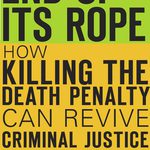
“The death penalty in the United States is at the end of its rope [and] its abolition will be a catalyst for reforming our criminal justice system.” So argues University of Virginia Law Professor Brandon L. Garrett in his widely anticipated new book, End of Its Rope: How Killing the Death Penalty Can Revive Criminal Justice, which analyzes the reasons behind the steep decline in capital punishment in over the last 25 years. With the help of other researchers at the University of Virginia, Garrett analyzed death-sentencing data from 1990 to 2016, county by county. He found that numerous interrelated factors contributed to the decline: the drop in murders across the country, the creation of institutional capital defender offices that greatly improved the quality of representation, the availability of life without parole as a sentencing option, the cost of the death penalty system, and growing public awareness of exonerations and the risk of wrongly sentencing innocent defendants to death, fueled further by the abolition of capital punishment in some states and the abandonment of capital prosecutions by many counties. Local culture had a profound effect on death sentencing practices: Garrett found that states and counties that most frequently executed people developed what he terms a “muscle memory” for the practice and “imposed far more death sentences just as a function of having done so in the past.” But, the converse was also true: when a county stopped sentencing people to death, it was less likely to resume the practice. Garrett found that death sentences have now all but disappeared from rural America, and are now imposed mainly in larger, urban areas. Garrett told the The Marshall Project, “we found a strong county-level pattern of racial bias. Counties with more black residents have more death sentences. And counties with more white victims of murder have more death sentences. Call it a ‘white lives matter’ effect,” he said. In an interview with University of Virginia publicists, Garrett described the death penalty as “a failed experiment.” He said states’ recent efforts to reform death-penalty procedures to “save the death penalty from itself” have failed because “the bias, both racial and geographic, is too ingrained. Lawmakers have tried to speed up executions, but have instead seen more delays and botched executions. They have tried to insist on higher-quality proof, and have still seen exonerations of innocent death row inmates.” Garrett hopes that as the death penalty wanes, the lessons learned can buttress other efforts to reform America’s criminal justice system and to move away from “mass incarceration and harsh punishment more broadly.”
(M. Chammah, “Q & A, What’s Behind the Decline in the Death Penalty?,” Marshall Project, October 3, 2017; E. Williamson, “In ‘End of Its Rope,’ Garrett Follows Thread of Death Penalty’s Decline,” University of Virginia School of Law, News & Media, September 18, 2017.) See Books, Studies, Costs, Innocence, Life Without Parole, Murder Rates, Race, Representation, and Sentencing.
Brandon Garrett is a member of the Death Penalty Information Center Board of Directors, joining the Board in September 2016.
Innocence
Nov 25, 2024


